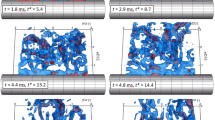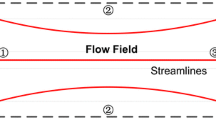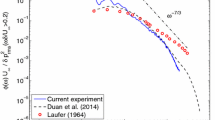Abstract
We examine the dynamics of a high-speed shock-induced flow near the open end of a shock tube using the particle image velocimetry (PIV) and the background oriented schlieren (BOS) methods along with two- and three-dimensional numerical simulations. In experiments, planar shock waves (\(M=1.3\)–1.6) are discharged from a rectangular (\(24\,\hbox {mm} \times 48\,\hbox {mm}\)) low-pressure section of a shock tube open to the atmosphere. Due to the rectangular exit geometry, the resulting flow is highly three-dimensional and, thus, more complicated, compared to well-studied circular/axisymmetric geometries. The study focuses on the spatio-temporal flow structure up to 1 ms after the shock wave diffraction. PIV and BOS visualization techniques share the same post-processing principle, and the iterative multi-step cross-correlation algorithm applied in the PIV software is adapted here for the calculation of background pattern displacement on the BOS images. Particular attention is given to the resolution of flow regions where sharp gradients are present, such as a diffracted shock front or embedded shocks. Computational fluid dynamic simulations of the problem are also conducted to validate the experimental results and methods and to gain more insight into the three-dimensional flow dynamics. PIV and BOS images are found to be consistent with the corresponding numerical flow visualizations.









Similar content being viewed by others
References
Lighthill, M.J.: The diffraction of blast I. Proc. R. Soc. A 198, 454–470 (1949)
Bazhenova, T.V., Gvozdeva, L.G., Nettleton, M.A.: Unsteady interactions of shock waves. Prog. Aerosp. Sci. 21, 249–331 (1984)
Golub, V.V., Bazhenova, T.V.: Pulsed Supersonic Jet Streams (in Russian), p. 279. Nauka, Moscow (2008)
Brouillette, M., Hebert, C.: Propagation and interaction of shock-generated vortices. Fluid Dyn. Res. 21, 159–169 (1997)
Abe, A., Takayama, K.: Numerical simulation and density measurement of a shock wave discharged from the open end of a shock tube. JSME 33, 246–223 (1990)
Maeno, K., Kaneta, T., Morioka, T., Honma, H.: Pseudo schlieren CT measurement of three-dimensional flow phenomena on shock waves and vortices discharged from open ends. Shock Waves 14, 239–249 (2005)
Murugan, T., Das, D.: Characteristics of counter-rotating vortex rings formed ahead of a compressible vortex ring. Exp. Fluids. 49, 1247–1261 (2010)
Arakeri, H., Das, D., Krothapalli, A., Lourenco, L.: Vortex ring formation at the open end of a shock tube: a particle image velocimetry study. Phys. Fluids. 16, 1008–1019 (2004)
Yu, Q., Grönig, H.: Shock waves from an open-ended shock tube with different shapes. Shock Waves 6, 249–258 (1996)
Mizukaki, T.: Visualisation of compressible vortex rings using the background-oriented schlieren method. Shock Waves 20(6), 531–537 (2010)
Murugan, T., De, S., Dora, C.L., Das, D.: Numerical simulation and PIV study of formation and evolution of compressible vortex ring. Shock Waves 22, 69–83 (2012)
Bazarov, S.B., Bazhenova, T.V., Bulat, O.V., Golub, V.V., Shulmeister, A.M.: Three-dimensional diffraction of shock wave. In: Takayama, K. (ed.) Proceedings of the 18th International Symposium on Shock Waves, pp. 251–254. Springer, Berlin Heidelberg (1992)
Bazhenova, T.V., Bazarov, S.B., Bulat, O.V., Golub, V.V., Schulmeister, A.M.: Experimental and numerical study of shock wave attenuation at the outlet of two-dimensional and axisymmetric ducts. Fluid Dyn. 28, 590–593 (1993)
Bazhenova, T.V., Bazarov, S.B., Golub, V.V., Shulmeister, A.M., Bormotova, T.A.: Shock wave diffraction from a square channel. High Temp. 35(2), 350–350 (1997)
Zare-Behtash, H., Kontis, K., Gongora-Orozco, N.: Experimental investigation of compressible vortex loops. Phys. Fluids. 20, 126105 (2008)
Zare-Behtash, H., Kontis, K., Gongora-Orozco, N., Takayama, K.: Shock wave induced vortex loops emanating from nozzles with singular corners. Exp. Fluids 49, 1005–1019 (2010)
Gutmark, E.J., Grinstein, F.F.: Flow control with noncircular jets. Annu. Rev. Fluid Mech. 31, 239–272 (1999)
Sun, M., Takayama, K.: The formation of a secondary shock wave behind a shock wave diffracting at a convex corner. Shock Waves 7, 287–295 (1997)
Bazhenova, T.V., Bormotova, T.A., Golub, V.V., Kotelnikov, A.L., Makeich, A.A., Shcherbak, S.B.: The formation of vortex shocks in a 3D subsonic flow behind a weak shock wave emerging from a channel. Tech. Phys. Lett. 28, 687–689 (2002)
Havermann, M., Haertig, J., Rey, C., George, A.: PIV measurements in shock tunnels and shock tubes. Topics Appl. Phys. 429–443 (2008)
Boiko, V.M., Pivovarov, A.A., Poplavski, S.V.: Measurement of gas velocity in a high-gradient flow, based on velocity of tracer particles. Combust. Explos. Shock Waves 49(5), 548–554 (2013)
Richard, H., Raffel, M.: Principle and applications of the background oriented schlieren (BOS) method. Meas. Sci. Technol. 12(9), 1576–1585 (2001)
Raffel, M.: Background-oriented schlieren (BOS) techniques. Exp Fluids. 56, 1–17 (2015)
Glushko, G.S., Ivanov, I.E., Kryukov, I.A.: Computational method for turbulent supersonic flows. Math. Models Comput. Simul. 2, 407–422 (2010)
Toro, E.F., Spruce, M., Spears, W.: Restoration of the contact surface in the HLL Riemann solver. Shock Waves 4, 25–34 (1994)
Acknowledgments
This work was supported by the Russian Foundation for Basic Research (Grants 12-08-01018–a, 15–08–02417–a) and partially by the Lomonosov Moscow State University Program of Development. The authors are also grateful to Dr. Jan Deca (KU Leuven) for his suggestions during the development of the parallel version of the CFD code.
Author information
Authors and Affiliations
Corresponding author
Additional information
Communicated by A. Podlaskin and A. Higgins.
This paper is based on work that was presented at the 21st International Symposium on Shock Interaction, Riga, Latvia, August 3–8, 2014.
Rights and permissions
About this article
Cite this article
Koroteeva, E.Y., Znamenskaya, I.A., Glazyrin, F.N. et al. Numerical and experimental study of shock waves emanating from an open-ended rectangular tube. Shock Waves 26, 269–277 (2016). https://doi.org/10.1007/s00193-016-0650-3
Received:
Revised:
Accepted:
Published:
Issue Date:
DOI: https://doi.org/10.1007/s00193-016-0650-3




